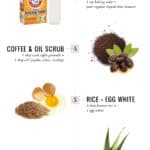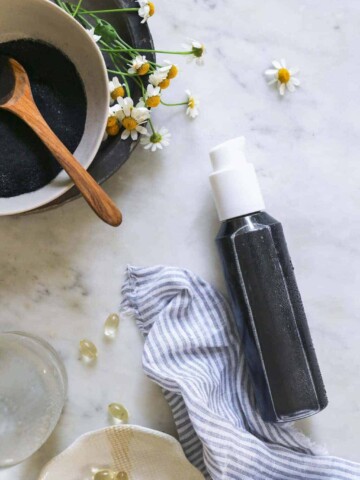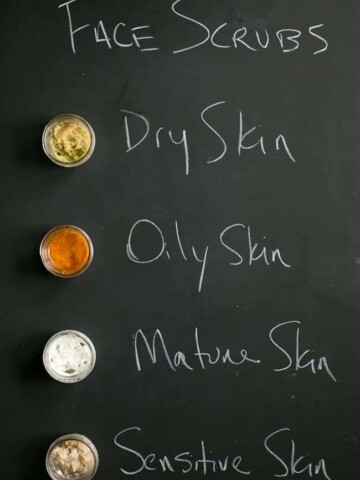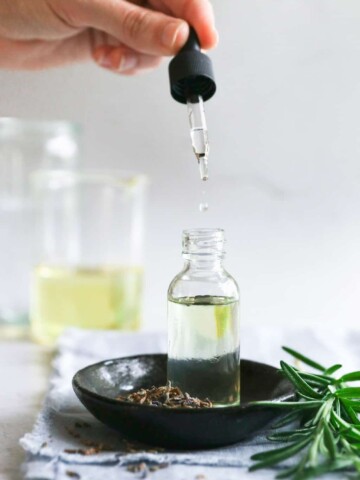Simple homemade face scrubs are the perfect recipes to attempt if you’re new to do-it-yourself skin care. The ingredients are inexpensive and easy to find. Plus, you probably have most of them in your kitchen already, and it’s so fun when you’re able to use what you already have.
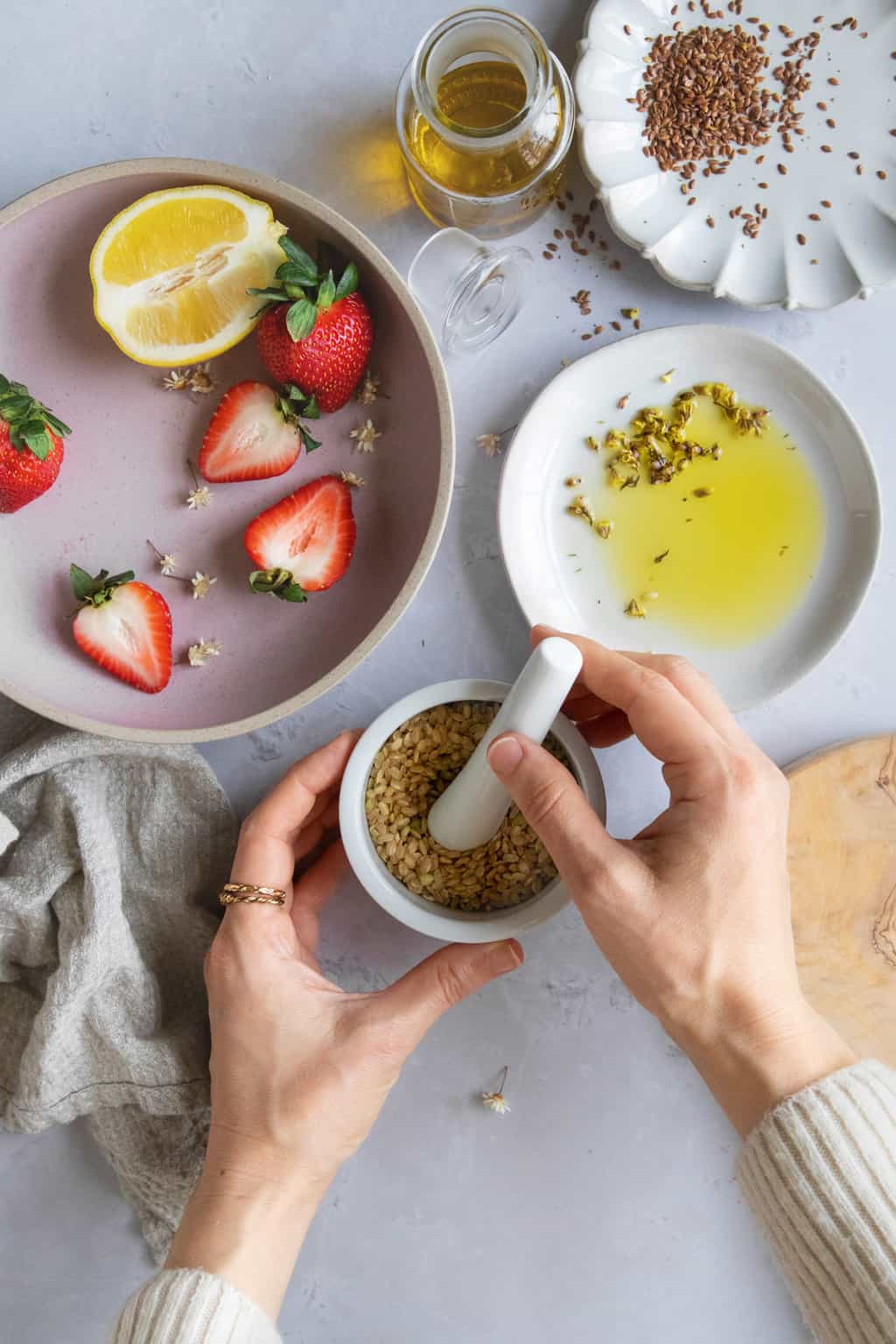
The beauty of face scrubs is that they provide exfoliation (aka one of the most underrated steps in a skincare routine).
Give any one of these simple facial scrubs a try—most of these contain two ingredients or less!—and your skin will feel soft and smooth.
Jump to:
Meet the Experts
- Olivia Rose, N.D., a Toronto-based naturopathic doctor and director of the Rose Health Clinic
- Rina Allawh, M.D., a dermatologist at Schweiger Dermatology Group in King of Prussia, Pennsylvania
- Jennifer Haley, M.D., a board-certified dermatologist and Hello Glow medical reviewer
What Is Exfoliation?
"Exfoliation, or the process of removing dead skin cells and trapped debris from the skin, promotes cell turnover, allows serums and moisturizers to penetrate the skin more easily, and helps to unclog pores. It also helps even out skin texture, which results in brighter and smoother skin," explains Olivia Rose, N.D., Toronto-based naturopathic doctor and director of the Rose Health Clinic.
Without exfoliating, we won't know our skin's potential. But it's easy to get wrong—too much, too little, wrong technique, and so on. This guide will help you learn how to exfoliate your face correctly!
Exfoliation is generally accomplished in one of two ways:
Physical exfoliation
Physical exfoliation refers to the removal of dead cells from the skin's surface wherein certain tools are used to manually scrub them off and open up pores, such as facial scrubs, gommage, microexfoliating rollers, and ultrasonic devices [source].
It can be applied with granules or beads and performed by your dermatologist, medical aesthetician, or by yourself at home using homemade scrubs.
Chemical exfoliation
Chemical exfoliation, on the other hand, uses products containing alpha-hydroxy acids (AHAs), such as glycolic acid or lactic acid, and beta-hydroxy acids (BHAs), such as salicylic acid [source].
Such compounds help dissolve fats or lipids in the superficial layers of skin to help shed these unwanted dead cells and their by-products, such as keratin and sebum or oil, explains Rina Allawh, M.D., a dermatologist at Schweiger Dermatology Group.
Sometimes you will find AHAs in peels, serums, and even in some moisturizers. When the dead skin cells are adherent, they clog pores and lead to cosmetically displeasing acne breakouts.
Both physical and chemical exfoliation techniques are helpful to incorporate into our weekly routines since they each serve a different purpose and act synergistically to achieve the best results.
Why Do We Need To Exfoliate?
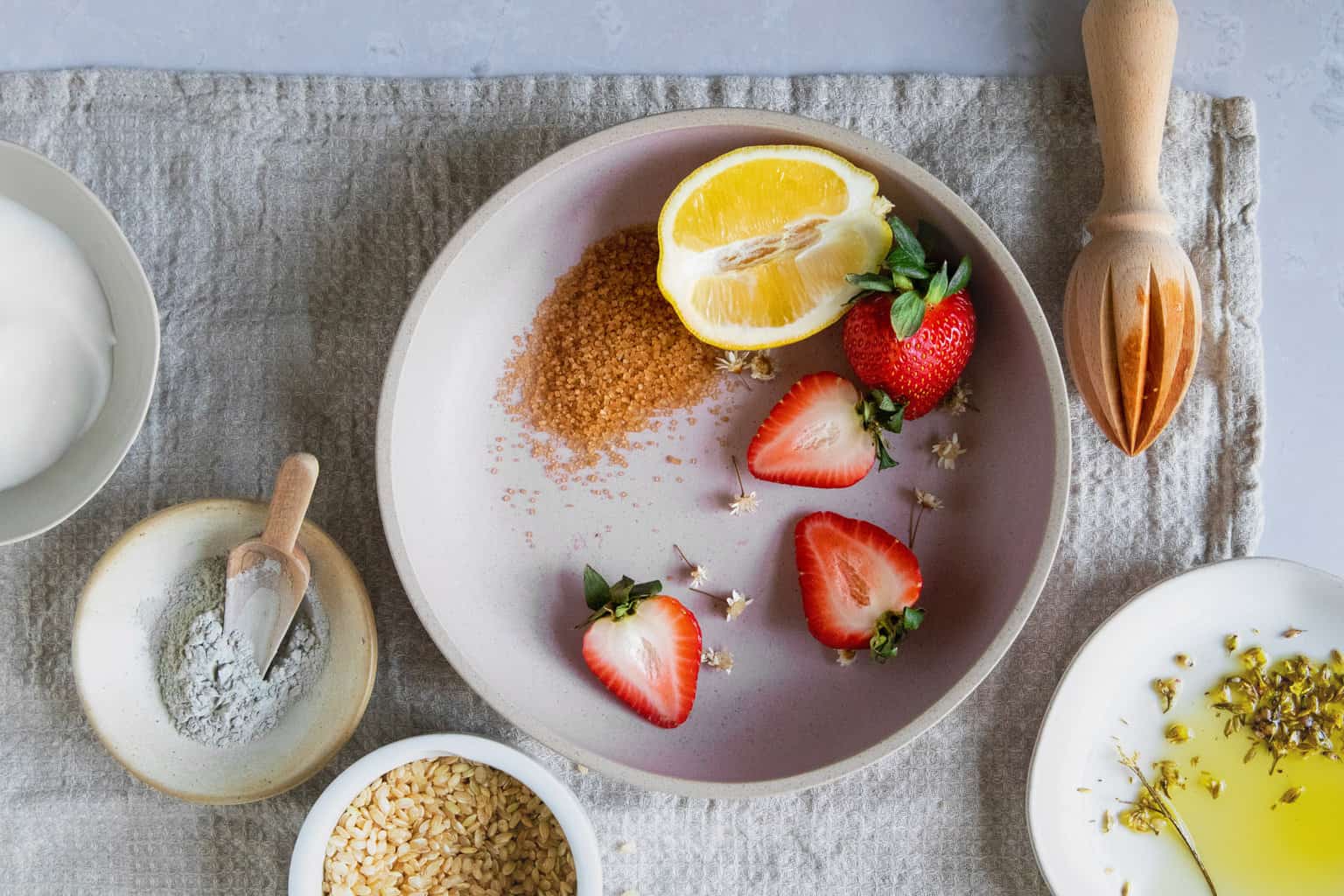
Dead skin, makeup, sweat, oil, UV rays, and free radicals (another term for toxins in the body) all take a serious toll on our skin. And age impacts this process, as well.
When we are kids, our skin does a fabulous job of sloughing off those layers naturally. But it gets tougher for our skin to do the job on its own when we get older, and our self-exfoliation rate slows down [source].
We also don’t make fresh skin as quickly, and the dead layers stay around on the surface a little too long. These dead skin cells hold onto irregular pigment particles, making our skin appear dull, uneven, and blemished.
These sticky cells end up clogging our pores, causing blemishes. This can result in acne and uneven pigmentation, in addition to a lackluster appearance. So this is why we exfoliate—to help our skin do its job!
Benefits of Exfoliation
Exfoliation can help:
- Brighten skin
- Even out skin tone
- Prevent and manage breakouts
- Alleviate pore clogging
- Hydrate and moisturize new skin
Exfoliation can help every item in your skincare routine work as intended, from serums to body lotions. When dead skin cells are not exfoliated properly, they insulate your healthy skin underneath and keep it from absorbing the active ingredients in your skincare regimen [source].
By properly exfoliating in moderation without irritating your skin, you will minimize breakouts, create a more even tone, optimize the absorption of therapeutic ingredients, and stimulate the stem cells at the base of your skin to renew themselves naturally.
How To Make Homemade Face Scrub Recipes
Play around and find your personal best scrub recipe using some of the easy-to-make ideas below. In general, to make your own recipe, you need:
- A tablespoon or two of a scrubbing agent
- A liquid or oil to make a paste
- Any extras to give your scrub a boost
Dry Skin Facial Scrubs

Key ingredients
Exfoliants: Brown sugar, ground coffee, and ground almonds will leave dry skin nourished and hydrated while the fine grains gently buff the skin.
Liquid: Coconut oil contains moisturizing fats and lauric acid that improves barrier function, protecting and softening the skin [source]. Or try a yogurt scrub base containing lactic acid, which gently exfoliates the skin while the fats and proteins pump up fine lines.
Enhancers: Avocados are full of good fats that moisturize dry skin [source]. Or try raw honey to draw in moisture. Strawberries and lemon juice add a dose of natural vitamin C.
1. Soothe dry skin with a Honey & Brown Sugar Face Scrub
Honey and sugar preserve moisture, aka natural humectants, and can be used to make a gentle scrub that buffs away flakes, clears out pores, and locks in moisture. Sugar scrubs are commonly used for body exfoliation, and finer textured sugars make good DIY face scrubs—just remember to be gentle.
"The gritty texture of sugar before it dissolves allows us to manually remove dead skin cells and oil," says Dr. Allwah. "Sugar scrubs are also not too harsh or abrasive in their quality and dissolve nicely."
—1 tablespoon brown sugar (the finer, the better)
—1 tablespoon honey, preferably raw
Mix the brown sugar and honey together. Then, with clean fingertips, very gently apply the scrub to your face in small circular motions to aid in the exfoliation process without damaging the skin.
Rinse with warm water, and use a washcloth to remove any residual honey, if needed.
2. Perk up parched skin with a Coffee Face Scrub
Leftover coffee grounds are mild enough to use for an all-over-the-body scrub—even on sensitive areas like the face. "Coffee grounds can improve circulation and reduce cellulite," says Dr. Rose. "It’s a great body exfoliator best used in the shower and especially in the morning."
—1 tablespoon used coffee grounds
—1 tablespoon oil (coconut oil, olive oil, or rosehip seed oil)
Talk about reduce, reuse, and recycle! Don’t throw away the used coffee grounds after making your morning brew. Just add 1 tablespoon of oil to them, and you’ve got a gentle, collagen-boosting scrub ready to go.
Coffee scrubs with added essential oils are also great for cellulite-prone areas of the body [source].
3. Hydrate and heal skin with an Almond Jojoba Scrub
Another common kitchen ingredient is raw almonds, which make a soothing and hydrating cleansing scrub. While you will need to grind them very finely in a coffee grinder or food processor, the result will be smoother skin than when you started.
Jojoba oil is noncomedogenic and helpful for use on oily skin prone to breakouts. It is anti-inflammatory and has been shown to possess wound healing and antiaging benefits [source].
—12 raw almonds
—1–2 tbsp jojoba oil
After grinding the raw almonds into a fine powder, add the jojoba oil, and then gently apply the mixture to the face in circular motions. Remove with a warm washcloth.
4. Brighten complexion with a Berry + Olive Oil Scrub
Strawberries and lemons are both sources of vitamin C, which helps fade skin discoloration and boost radiance [source]. The brown sugar sloughs away dry skin flakes, and olive oil replenishes moisture. Feel free to polish your lips as well!
—4 ripe strawberries, mashed
—3 tablespoon extra virgin olive oil
—¼ cup brown sugar
—Juice of ½ a lemon
Combine these ingredients, and apply the mixture to damp skin twice a week. Rinse and follow with moisturizer.
5. Smooth dry patches with Sage Polish
This scrub whisks away unwanted dry patches. Sage is an antioxidant that scavenges free radicals [source]. It also contains vitamin A, which has powerful antiaging effects and helps generate new skin cells for softer, healthier skin [source].
Oatmeal contains anti-inflammatory compounds that soothe irritation [source]. It’s great for most skin types, including sensitive skin, notes Dr. Rose. "It works as a gentle exfoliant that also adds moisture to dry skin," she says.
—1 teaspoon chopped sage
—2 tablespoon oatmeal
—2 tablespoon olive oil
Combine ingredients and massage into damp skin for 1 minute, then rinse.
DIY Face Scrubs for Oily Skin
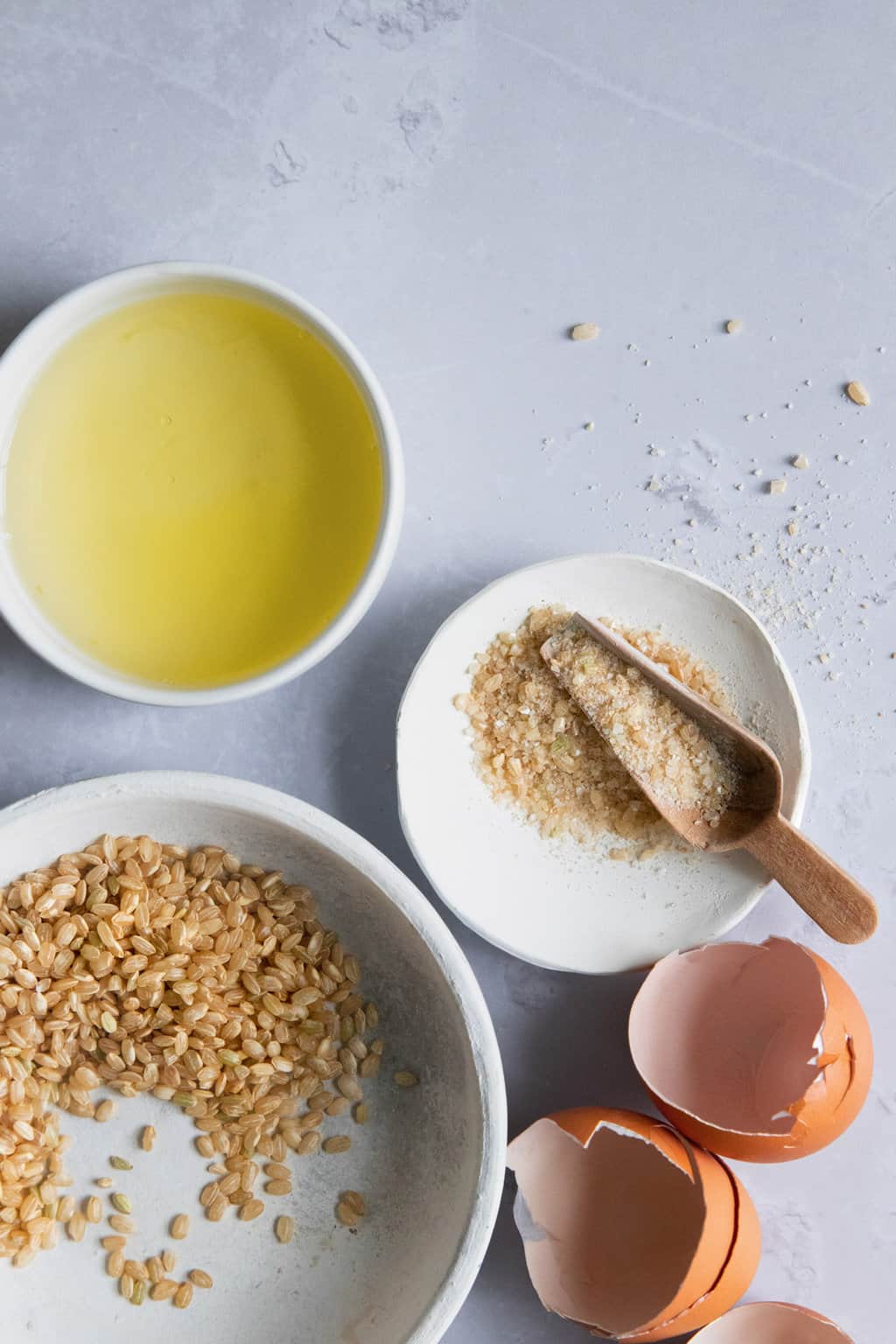
Key ingredients
Exfoliant: Baking soda and rice flour not only have a superfine texture, but they also help curb excess oil.
Liquid: Egg whites are your friend, addressing oil while also firming and tightening—a bonus!
Enhancers: Turn to turmeric when you want to beat breakouts and fade acne scars. Or try a tomato or citrus infusion for added vitamin C.
6. Baking Soda Facial Scrub Add-In
With its superfine texture, baking soda acts like an at-home microdermabrasion for all skin types. This inexpensive ingredient also absorbs excess oil, so it's especially helpful for oily skin.
—1 teaspoon baking soda
—Your regular liquid skin cleanser
Possibly the easiest scrub to make, just add 1 teaspoon of baking soda into a small amount of your regular cleanser, and you’ve just made your routine product work double duty as an exfoliating cleanser.
7. Brightening Rice Flour Facial Scrub
Ground rice powder makes an excellent cleanser for brightening complexions and lightening skin discolorations. Brown rice flour scrubs help polish away dead skin cells and lessen the appearance of residual acne marks for acne-prone skin.
Plus, it has oil-absorbing and anti-inflammatory benefits that help both oily and sensitive skin types. Combine with a tablespoon of ground almonds if you're battling aging.
—2 tablespoon brown rice
—1 egg white
Using a coffee grinder, grind brown rice grains until fine. Add an egg white and whip to create a paste.
Then gently massage the scrub into the skin in small circular motions to dislodge dead cells. Rinse with warm water to remove.
8. Glowing Skin Turmeric Scrub
Despite its reputation for staining whatever it comes into contact with, turmeric masks actually work to even out your natural skin tone. It contains natural anti-inflammatory compounds such as curcumin [source], and its texture provides excellent exfoliation.
Turmeric is also said to help regulate the skin's oil production, and it’s been shown to improve barrier function [source], all of which are beneficial for acne-prone skin.
Chickpea flour helps speed up cell turnover to reveal new, glowing skin underneath, while the fatty acids in almond oil leave the complexion looking instantly dewy and youthful.
—2 tablespoon chickpea flour
—½ teaspoon organic turmeric powder
—2 tablespoon sweet almond oil
Mix all ingredients in a small bowl, and stir to combine. Using clean hands, massage over clean, damp skin with your fingertips, starting with your chin and working upward in small circles. Rinse and follow with moisturizer.
If you experience any skin discoloration from the turmeric, don't fret—it's not permanent! Rinse again with water or use a gentle cleanser (like this rice milk one) to remove any leftover yellow tint.
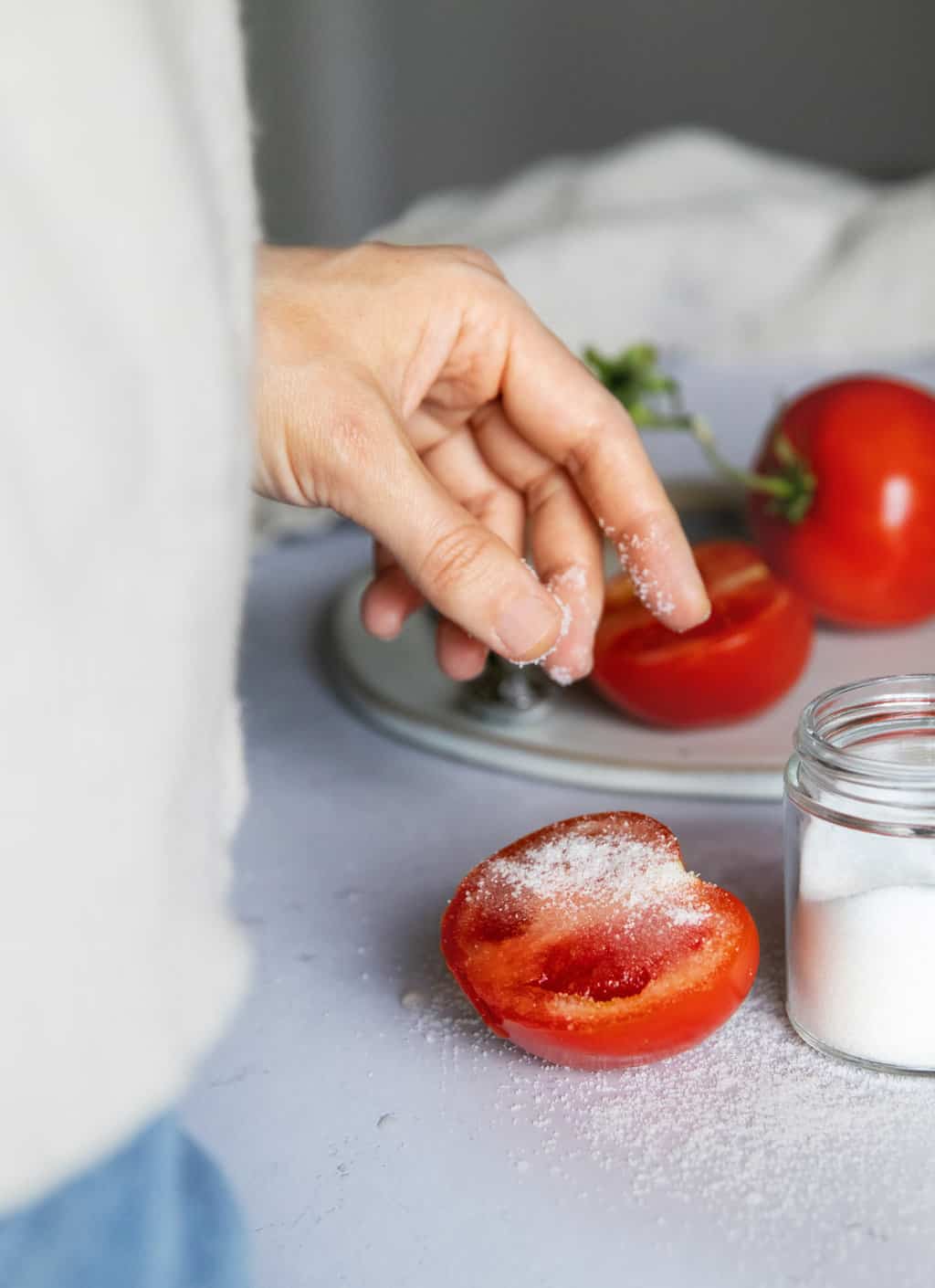
9. Banish blemishes with a Tomato Scrub
Tomatoes are full of blemish-busting vitamin A, which speeds up cell turnover to reveal a clear complexion. Plus, they're said to be a natural oil-controlling astringent.
—1 half of a tomato
—½ teaspoon fine sugar
Sprinkle sugar over the juicy flesh of the tomato. Move the sugar-covered fruit over your face gently, paying special attention to your nose, forehead, and chin areas.
Let the juice sit for 5 minutes and then rinse and pat dry.
10. Nix acne with a Nutmeg Scrub
The antibacterial and anti-inflammatory properties of nutmeg [source] help reduce redness and unclog pores. The baking soda and the lactic acid in whole milk help to whisk away dead skin cells and excess oil.
—1-2 tablespoon whole milk
—½ tablespoon ground nutmeg
—½ tablespoon baking soda
Combine the ingredients in a bowl and combine well. Use your middle and ring fingers to apply the mixture to your face, gently massaging into the skin, avoiding the eye area.
Feel free to concentrate on the décolleté area as well. After a few passes, rinse with warm water and follow with moisturizer.
11. Unclog pores with an Orange Peel Scrub
If your skin is prone to clogged pores, add a pinch of dried orange peel to your face wash. The citrus oils—all found in the fruit's peel—break down dead skin cells, while their grainy texture provides gentle physical exfoliation.
—Peels from 2–3 oranges, dried
—Your regular liquid facial cleanser
Let the peels air-dry in a sunny window for a few days, then grind them in a coffee or spice grinder until you have a fine consistency. Add a small amount to your regular facial cleanser 2–3 times a week.
Homemade Face Scrubs for Sensitive or Inflamed Skin
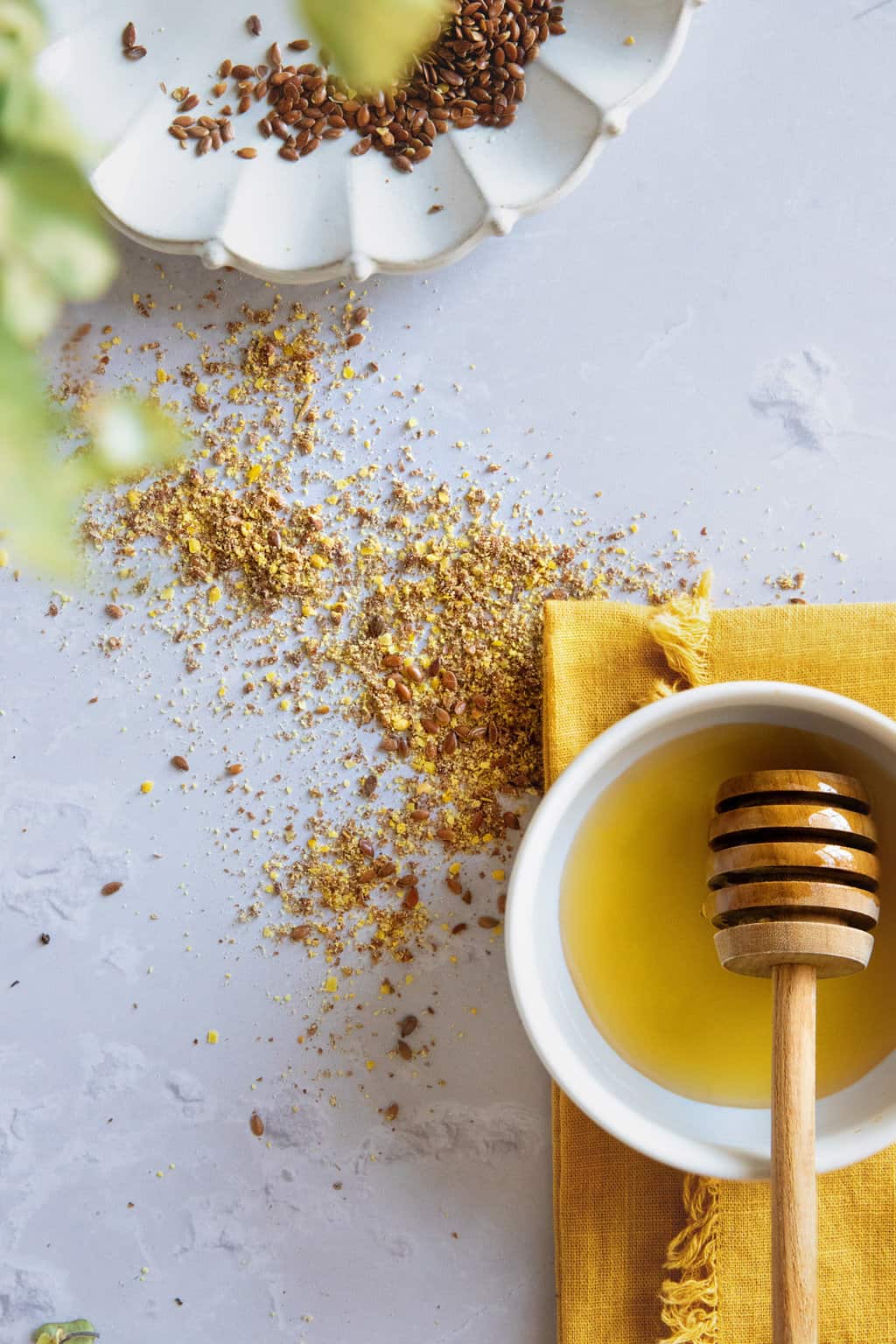
Key ingredients
Exfoliant: Oats are perfect for this skin type. Use them whole or grind them into a fine powder. Flaxseeds are another gentle and anti-inflammatory scrub base.
Liquid: Aloe vera is great for keeping skin clear and healthy, and it does an excellent job of reducing inflammation [source].
Enhancers: Add a bit of honey to calm red or irritated skin [source]. Plus, it works as a humectant that draws in moisture [source].
12. The best exfoliator for sensitive skin is an Oatmeal Scrub
Soothing and anti-inflammatory oats are ideal for sensitive skin. Ground oats gently unclog pores while their natural saponins cleanse and absorb dirt and oil.
—½ cup old-fashioned oats (uncooked)
—Water
In a blender, pulse the dry oats until finely ground. Place a pinch of the ground oats into the palm of your hand, then add water until a paste forms.
Gently massage your face and neck. Store the ground oats in an airtight container for later use.
Bonus: Instead of water, you can use milk or plain yogurt, both of which have lactic acid, which can be helpful as a chemical exfoliant. Or add apple cider vinegar that contains malic acid for its brightening properties.
13. Soothing Aloe Vera Gel & Sugar Facial Scrub
Superfine sugar is a great kitchen ingredient to add to your scrub. The finer the grit, the better for your skin.
Aloe vera is known to be soothing and healing for all skin types, even acne-prone skin, notes Dr. Rose. "It is a highly moisturizing, hydrating gel, yet it doesn’t clog pores, so even the oiliest of skins can benefit," she says.
Learn how to make your own aloe vera gel to save even more money.
—1 tablespoon aloe vera gel
—A sprinkle of superfine sugar
Combine the two ingredients. Gently massage them into your skin, leave the mixture on for a few extra minutes, and then rinse well to remove.
14. Reduce inflammation with a Flax Seed Face Scrub
Flax seeds are anti-inflammatory both internally and externally [source]. You can add different ingredients to a handful of flax seeds and create various scrubs for different facial needs. You'll get a gel-like consistency that's gentle yet effective at removing dead skin cells.
—1 teaspoon ground flax seeds or flaxseed meal
—1 tablespoon carrier ingredient (aloe vera gel, yogurt, honey)
Mix well with a mortar and pestle and apply to the face, then remove with warm water.
Tips for Using a Homemade Facial Scrub
Use before bed: Nighttime is the best time for a good scrub. This allows your skincare products to better absorb while you sleep.
Start clean: Use a natural face cleanser first to remove surface oil and makeup. The skin doesn’t have to be dry if you’ve just washed your face or taken a shower.
Be gentle: The goal with any facial exfoliant is to gently lift off dead skin cells without abrading healthy skin. Facial scrubs typically use finer ingredients so as not to scratch, irritate, or damage the tissues. If your face burns or is red, you are being too aggressive.
Apply in circles: Scrubs should be applied gently and in circular motions using your lightest touch and avoiding the eye area.
Be consistent: Most people find that 1–3 times a week is sufficient for exfoliation, but this will change with age, hormones, climates, and seasons. Be patient and consistent in your skincare regimen to get the best long-term results.
Want more facial scrubs customized for dry, oily, mature, and sensitive skin? Don't let parched, dry skin get in the way of your glow!
References
References:
1. Rodan K, et al. Skincare boot camp: the evolving role of skincare. Plast Reconstr Surg Glob Open. 2016.
2. Grajqevci-Kotori, et al. Exfoliative skin-peeling, benefits from this procedure and our experience. Med Arch. 2015.
3. Li W, et al. Influence of exfoliating facial cleanser on the bio-tribological properties of human skin. Wear. 2013.
4. Lin TK, et al. Anti-inflammatory and skin barrier repair effects of topical application of some plant oils. Int J Mol Sci. 2018.
5. Bhuyan DJ, et al. The odyssey of bioactive compounds in avocado (Persea americana) and their health benefits. Antioxidants (Basel). 2019.
6. Herman A, et al. Caffeine’s mechanisms of action and its cosmetic use. Skin Pharmacol Physiol. 2013.
7. Al-Niaimi F, et al. Topical vitamin C and the skin: mechanisms of action and clinical applications. J Clin Aesthet Dermatol. 2017.
8. Hamidpour M, et al. Chemistry, pharmacology, and medicinal property of sage (Salvia) to prevent and cure illnesses such as obesity, diabetes, depression, dementia, lupus, autism, heart disease, and cancer. J Tradit Complement Med. 2014.
9. Glass GE. Cosmeceuticals: the principles and practice of skin rejuvenation by nonprescription topical therapy. Aesthet Surg J Open Forum. 2020.
10. Pazyar N, et al. Oatmeal in dermatology: a brief review. Indian J Dermatol Venereol Leprol. 2012.
11. Vollono L, et al. Potential of curcumin in skin disorders. Nutrients. 2019.
12. Kim L, et al. Turmeric, curcumin, and curcuminoids: a dermatologic review. Pract Dermatol. 2020.
13. Naeem N, et al. Nutmeg: a review on uses and biological properties. Int J Chem Biochem Sci. 2016.
14. Surjushe A, et al. Aloe vera: a short review. Indian J Dermatol. 2008.
15. McLoone P, et al. Honey: a therapeutic agent for disorders of the skin. Cent Asian J Glob Health. 2016.
16. Mandal MD, et al. Honey: its medicinal property and antibacterial activity. Asian Pac J Trop Biomed. 2011.
17. Parikh M, et al. Dietary flaxseed as a strategy for improving human health. Nutrients. 2019.
This post was medically reviewed by Dr. Jennifer Haley, a board-certified dermatologist with extensive experience in medical, cosmetic, and surgical dermatology. Learn more about Hello Glow’s medical reviewers here. As always, this is not personal medical advice, and we recommend that you talk with your doctor.
833
